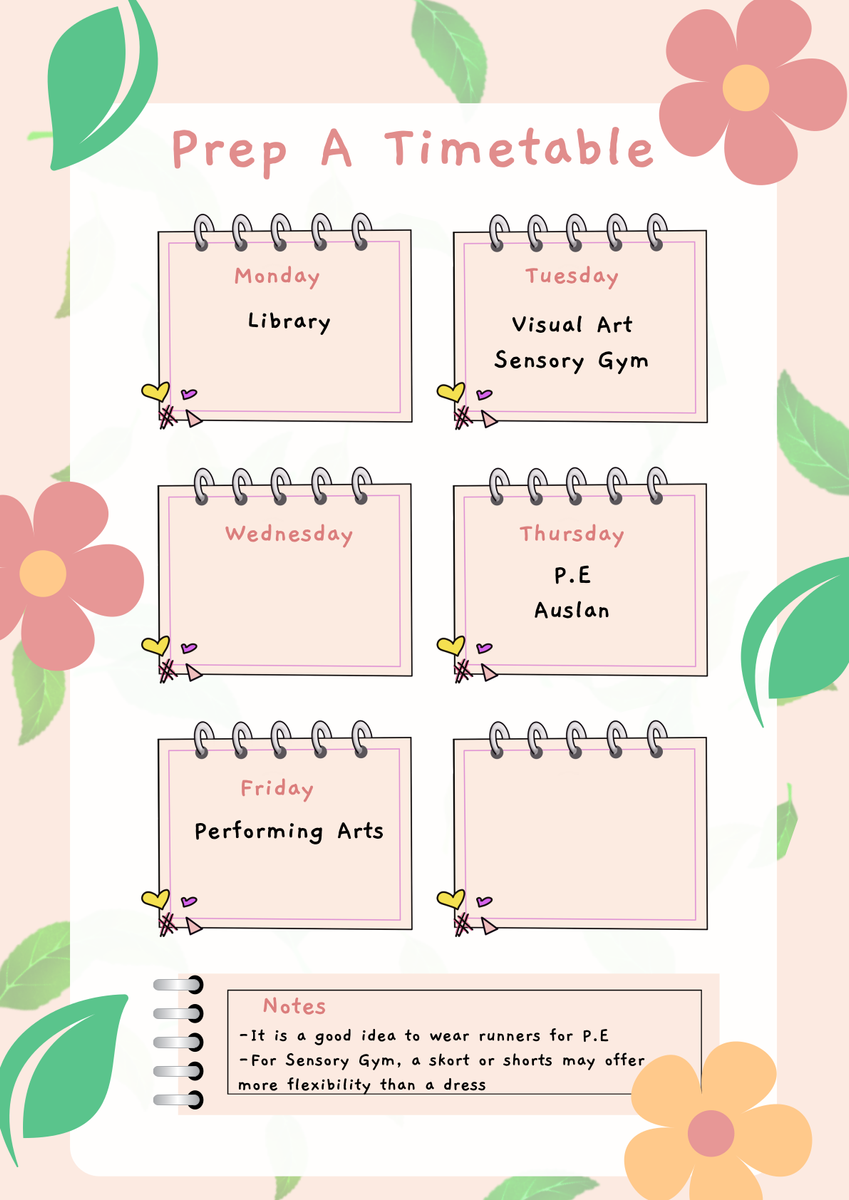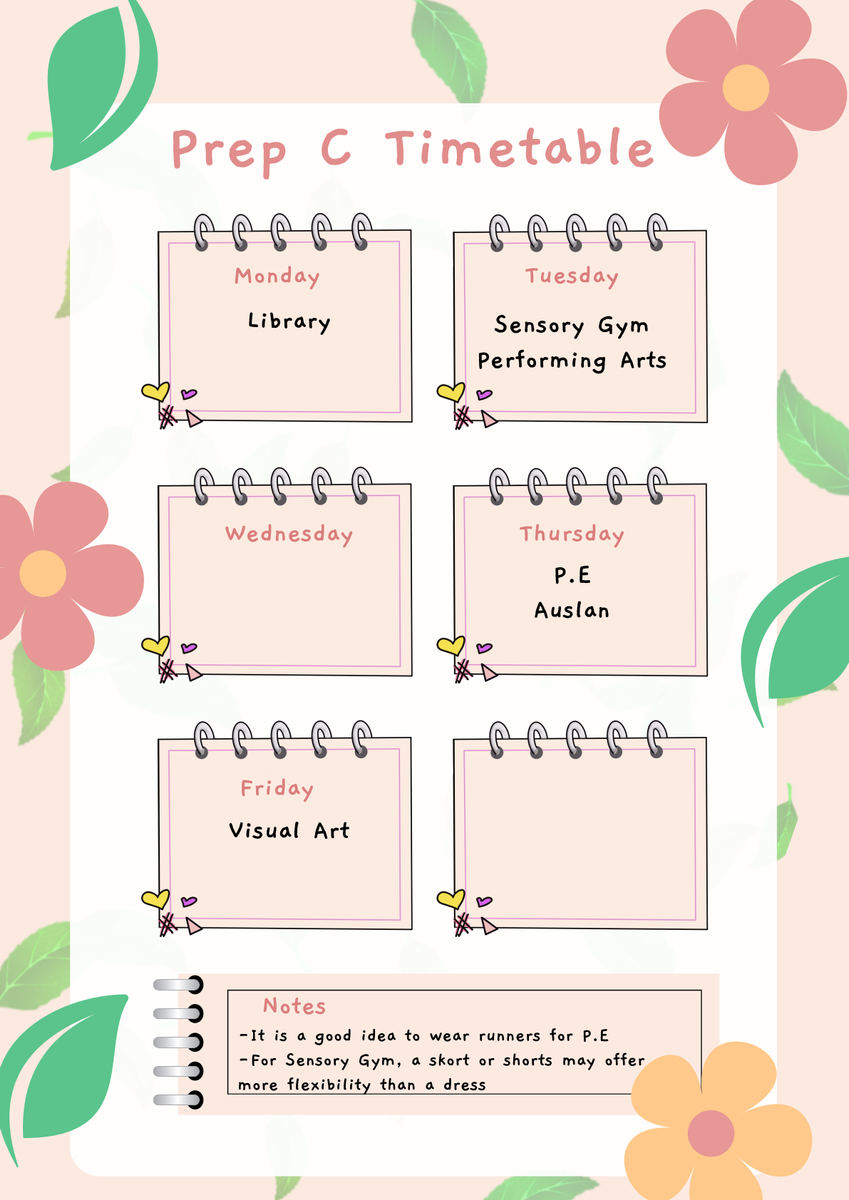Prep Wonga Weekly
Week 9, Term 1

Prep Wonga Weekly
Week 9, Term 1
INFORMATION
🗓️ Upcoming Dates:
Tuesday 25th March: Colour Run
Thursday 27th March: School Photos
Thursday 27th March - Final Volunteer Child Safety Meeting | 5:00 - 5:30 PM (online see below for link)
Friday 28th March: Cross Country (Please see Sentral for more information)
Friday 4th April: Last day of Term 1 - 2.30pm dismissal
📚 Book Pocket Reminders and tips
-Please remind your child to bring their book pocket every day to school. We will send home two decodable passages each week and other supplementary materials. (Note: books will start being sent home in Term 2. Not long now!)
-Re-reading these passages at home is highly beneficial because fluency matters. Fluency is key to becoming a strong reader and develops with repetition and practice. Fluent reading should be smooth and sound natural. Once your child has decoded (sounded out) the words, encourage them to re-read the passage with fluency.
-Reading Logs: They are checked every Friday - please remember to record the name of the passage / write the words that your child has read.
A note on phonemic awareness and decoding:
Blending three sounds to read words is a new skill for most Prep students. Developing phonemic awareness takes time and practice! (Phonemic awareness is the ability to hear, identify, and manipulate sounds in spoken words.)
-Try orally segmenting a three-letter word for your child (e.g., c-a-t), making sure to stretch the sounds so the word is easier to hear. Have your child listen and then say the whole word.
-If your child finds reading passages challenging, focus on individual words within the text and decode them together (e.g., p-o-t … pot).
📱iPads
We are getting ready to bring our iPads to school for the start of Term 2. This week, students will complete the iPad quiz and bring it home. It is important that you read through the quiz with your child so that you both understand that expectations of using an iPad at school.
🎨 Specialist timetable






CURRICULUM
📚 Phonemic awareness: reading and phonics
This week, we are focusing on the nasalised A and the short O vowel sound (as in octopus). Students will explore the phoneme (the sound it makes), the grapheme (how it is written with correct letter formation) and the corresponding cued articulation.
Additionally, students will practice reading and writing CVC words with the medial vowels A, I, and O (where the vowel appears in the middle of the word).
For sight word practice, students will review the Heart Words: the, and, I, a, and is, while also learning the new word as.
(*Nasalized A occurs when the letter M or N follows A, causing it to take on a slightly different sound—for example, can vs. cat)
What can you do at home?
-Read bedtime stories to your child
-Review the sound/letter names and cued articulation for letters taught so far - short A, M, S, T, P, F, short I and N
-Assist your child to read the decodable passages / CVC words in their book pocket
-If you're interested in Cued Articulation, you can watch Jane Passey (the founder) explain what it is. She also demonstrates the cued articulation for each phoneme.
https://www.youtube.com/watch?v=gyGX3RcLG74&ab_channel=cuedart48
📝 Literature: reading responses and writing
We will explore three mentor texts this week: Cat and Dog by Helen Oswald, Boss of Your Own Mind by Byll and Beth Stephen and How to Make Friends – A Bear's Guide by Cat Rabbit. These thoughtfully chosen books align with our CBL Guiding Questions and centre on the theme of friendship including how to build and maintain meaningful connections.
With Cat and Dog, students will revisit key story elements, focusing on problem and solution, as well as comparing characters. Boss of Your Own Mind will introduce students to Mind Maps, encouraging them to reflect on what they can control or influence versus what lies beyond their control. Finally, with How to Make Friends – A Bear’s Guide, students will enhance their oral language skills by engaging in interactive activities to discover shared interests. They will also create finger puppets to establish a setting and demonstrate the process of making friends.
By the middle of this week, we will know three vowels - A, I and O - allowing us to form more even more CVC (consonant-vowel-consonant) words. Using these words, we will write simple sentences.
Students will also practice handwriting with a focus on the letter o, while reviewing the formation of previously learned letters.
Additionally, we will incorporate activities to further develop fine motor skills essential for writing.
What can you do at home?
-Play with things that develop fine motor skills like lego, playdough, drawing and building blocks
-Help your child develop their pencil grip
-Write the letters A, M, S, T , P, F, I and N using taught lower case formations. Use these letters to write some words, using A and I as the middle vowels. Later in the week you can add in O too!
🔢 Maths
This week, students will dive into the world of shapes through fun and engaging activities. They’ll identify and create shape pictures using real-life examples, starting with squares, circles, triangles, and rectangles, and extending to ovals, hexagons and trapeziums. Through tracing, naming and counting shapes, as well as making shapes with their bodies, students will connect shapes to their properties in an interactive way. Play-based activities, like finding hidden shapes in pictures, will make learning both meaningful and exciting.
What can you do at home?
-Go on a shape scavenger hunt around the house or outside. Ask your child to find objects that match the shapes they’re learning about (e.g., squares, circles, triangles). Have them name the shapes and describe the properties (e.g., "This is a square because it has four equal sides")
-Play with play dough to make shapes.
-Play this online game. As you play, discuss the shapes you are using and their features.
https://www.abcya.com/games/shapes_geometry_game
🌏 CBL - Connections
This week, we are exploring some of our Guiding Questions through our mentor text discussions and tasks (see above in literature).
We are also developing our understanding of Connections through our Wellbeing programs of Friendology and Respectful Relationships - see below!
💛 Wellbeing & School Wide Positive Behaviour (SWPBS)
In Friendology, students are completing Session 6 called Friendship Fires. This session teaches students, step-by-step, how to resolve conflict with a friend and how to respond to hurt feelings and misunderstandings.
The 3 Steps are:
1.Retell the situation being as specific as possible.
Example: “Remember when I showed you my wiggly tooth and you said it was gross…”
2.Explain how it made you feel.
Example: “I felt sad. I felt like you were making fun of me.”
Note: Avoid saying things like, “You made me feel…” or “You were being…” or “That was mean!” The focus is on how the affected student felt, using an I-statement.
3.Listen to what the other person is saying. Truly listen to their side of the story.
*Apologies might need to be made, and a plan devised to try and avoid a similar situation in the future.
What can you do at home?
If your child shares their hurt feelings or a misunderstanding with a friend, you can help them practice resolving the conflict using the steps above.
Our SWPBS focus remains on the expectations of 'Be Kind' and 'Be Safe.' We continue to encourage inclusivity in games and making safe choices about where and how we play. Our understanding of 'Be Safe' also extends to classroom behaviour, including walking indoors and transitioning quickly and quietly between lessons
Volunteer Child Safe Training
Week 9: Thursday, 27th March | 5:00 - 5:30 PM (online)
https://eduvic.webex.com/eduvic/j.php?MTID=m338c73b0471873f39d56a73e6c91506f
We encourage all new volunteers or volunteers needed to update their training to attend one of these sessions to ensure compliance and to continue making a positive impact in our school community.